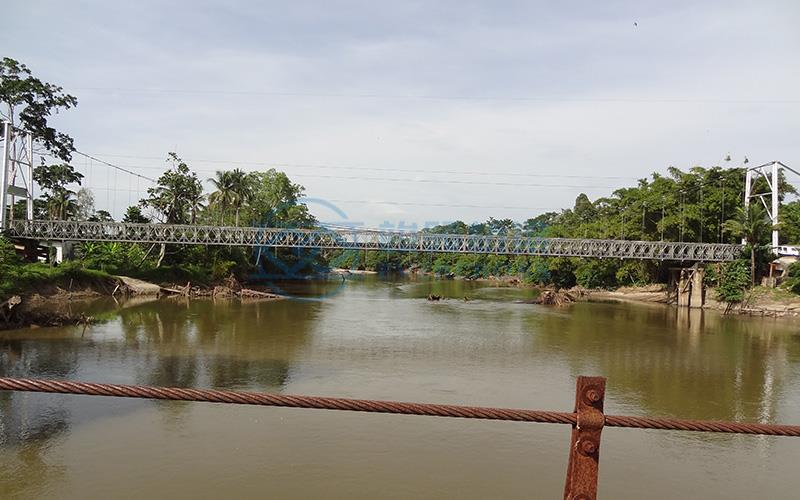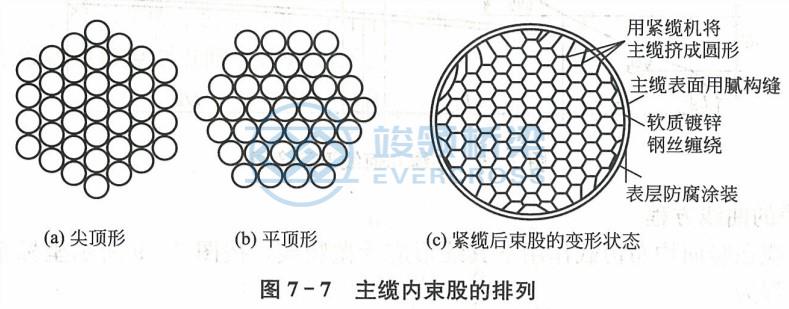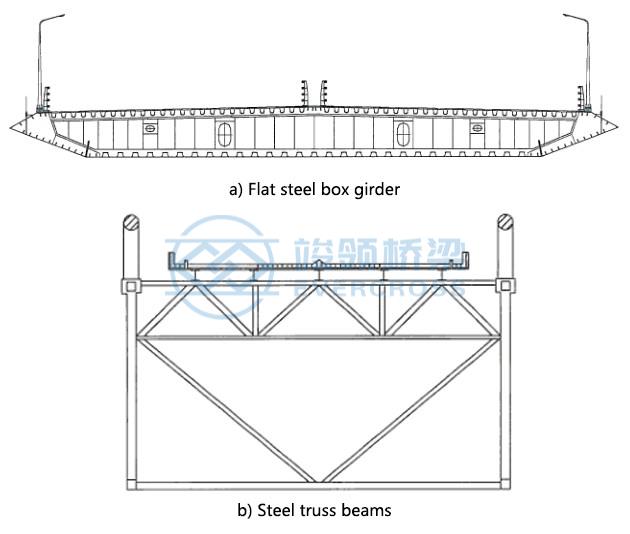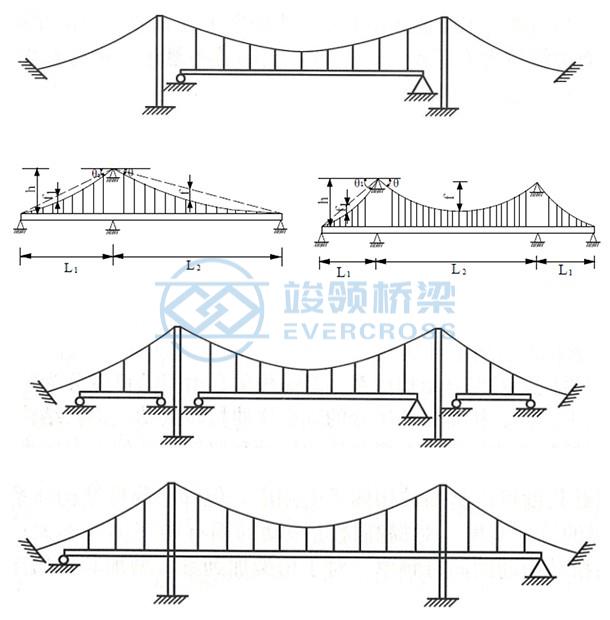Steel Cable Suspension Bridge

Description:
A flexible suspension combination system composed of a main cable and a stiffened beam has the stress characteristics of both cable and beam.
It consists of bridge tower, main cable, sling, stiffening beam, anchor, saddle and other main parts.
At present, most of the bridges with a span greater than 1000m are suspension bridge structures.

Load characteristics: the load is transmitted from the sling to the cable, and then the cable is transmitted to the anchor, to the pier and to the tower.
Under the external load, the main cable and stiffened beam bear the same force.
The main cable is the main load-bearing component, which deforms under load
It directly affects the internal force and deformation of the bridge.
The main cable is the main load-bearing component in the structural system, which is mainly strained.
The bridge tower is the main load-bearing component of suspension bridge to resist vertical load.
The stiffening beam is a secondary structure of suspension bridge to ensure vehicle running and provide structural stiffness, and it mainly bears bending internal force.
The sling is a force transmission component that transmits the self-weight and external load of the stiffened beam to the main cable, and is the link connecting the stiffened beam and the main cable.
An anchor is a structure that anchors the main cable, which transmits the tension in the main cable to the foundation.
Main cable: The load is borne by the clamps and boom, and it is passed directly to the top of the tower.
The main cable is divided into two types: wire rope main cable and parallel wire bundle main cable.
1.Wire rope main cable: wire rope main cable is twisted into strands by wire, and then twisted into rope by strands. Generally, it adopts 7 strands and used for small span suspension bridges.
2.Parallel wire bundle main cable
Prefabricated parallel steel wire strand method (PPWS method): the use of parallel steel wire to speed up the construction progress of the main cable, the section shape is divided into pointed and flat top shape.

Bridge Tower:
1. Bridge to form
According to the mechanical properties, it can be divided into three structural forms: rigid tower, flexible tower and rocking column tower.
A rigid tower refers to a bridge tower with relatively small horizontal displacement at the top. The flexible tower. It refers to the bridge tower with relatively large horizontal displacement at the top. Rocking column tower, it is only used for suspension bridges with small span, and the lower end is hinged single-column structure.
2. Cross bridge form
The bridge tower of transverse bridge adopts three forms: truss type, rigid frame type and mixed type structure.
Main parameters involved:
The main parameters that affect the design of bridge tower are: material parameters, environmental parameters and structural size parameters.

Stiffening beam:
The types of stiffened beams mainly include steel truss beams, steel box beams, concrete beams, steel-mixed composite beams and other structural forms, as shown in the figure:

Sling:
The material of the sling
It can be made of steel wire rope, parallel steel wire bundle or steel strand.
(2) Connection mode with cable clamp
Straddle type, pin type
(3) Vertical sling and diagonal sling
Traditional slings are vertical, starting with the Severn Bridge in the United Kingdom.
Anchorage:
The anchorage of ground anchored suspension bridge is divided into two structural forms: gravity anchorage and tunnel anchorage, as shown in the figure: Gravity anchorage is composed of anchor body, bollard, anchor chamber and foundation. Tunnel anchorage is composed of anchor plug body, loose saddle support pier and anchor chamber.
Compared with gravity anchorage, tunnel anchorage has much less concrete consumption and more significant economic performance. In terms of applicability only, gravity anchorage is suitable for almost all occasions. When the comprehensive geological condition of the anchor site is good, the terrain is conducive to the overall layout of the whole bridge, and the construction conditions can meet the tunnel excavation and slag discharge. From the economic point of view, the possibility of building tunnel anchors should be considered first. Only when the construction conditions are considered comprehensively and the comprehensive technical and economic comparison shows that tunnel anchors are obviously unsuitable, the gravity anchors are chosen to be built.

Saddle
The saddle sits between the main cable and the top of the tower. The saddle is an important member that supports the main cable and gives the main cable a turning angle here. Through it, the pull force in the main cable can be evenly transmitted to the top of the tower and the anchor in the form of vertical force and unbalanced horizontal force.
The saddle is divided into the main rope saddle at the top of the tower and the loose rope saddle at the anchor
Classification of suspension Bridges:
1.According to the number of suspension span are divided into: single-span suspension bridge, three-span suspension bridge, four-span suspension bridge, five-span suspension bridge.

2.According to the main cable anchoring form are divided into: ground anchor and self-anchoring.
Ground anchorage: The tension of the main cable is transferred to the foundation by the gravity anchorage or tunnel anchorage at the end of the bridge
Self-anchoring: The main cable tension is transmitted directly to its stiffening beam.

Adaptability of various suspension structures:
Suspension structure type | Single span simply supported | Double span continuous | Three span simply supported | Three span continuous |
Advantage | The linear shape of single-span suspension bridge is beautiful, because the sag of the main cable of the side span is small, the length of the main cable is relatively short, and the horizontal deformation of the bridge tower is small, which is more favorable to the deformation control of the mid-span load. | Novel shape | The shape is beautiful, the structural force is reasonable, the stiffened beam cannot through the bridge tower column, the bridge tower column can be arranged vertically, and the beam section of the bridge tower is simple to construct. | The shape is beautiful, the structural force is reasonable, and the deformation of the stiffened beam is small |
Shortcoming | It is slightly less aesthetically pleasing than the three-span structure | Self-anchoring or ground anchoring, the construction technology is complex, the economy is general, and the horizontal deformation of the bridge tower is large | The relative angle and expansion of the beam end of the adjacent span are larger, the transverse displacement of the stiffened beam is larger, and the mid-span deflection is larger | The bending moment of the stiffened beam at the bridge tower is larger, the foundation of the bridge tower is relatively larger, the fabrication error of the stiffened beam and the uneven settlement of the pier have great influence on the stress of the stiffened beam |
Applicability | The side span terrain is higher or the flat curve enters the side span, and the application range is wider | The terrain on both sides is higher, there are continents in the river, and the span is smaller | The edge span terrain is flat, the water depth is deep, the layout pier is high, and the application range is wide | The edge span terrain is flat, the water depth is deep, the layout pier is high, and the application range is wide |
Suspension bridge construction method:
The construction process of suspension bridge is: anchor foundation construction, anchor construction, bridge tower foundation construction, bridge tower construction, main cable construction, stiffened beam construction, bridge deck construction, etc.
Protection design
(1) Concrete structure
Concrete structure protection design mainly adopts the following measures:
①Improve the thickness of concrete protective layer.
②Adopting high performance concrete, with durability.
③The sound concrete coating or sealing layer has the characteristics of preventing the contact between the corrosive medium and the concrete, thus extending the life of concrete and reinforced concrete.
④Improve the steel bar material and steel bar coating.
⑤Add reinforcement corrosion inhibitor (rust inhibitor) to concrete.
⑥The concrete structure uses cathodic protection (protection) system.
(2) Steel structure
The protection design of suspension bridge steel structure mainly adopts the following measures:
①Paint coating.
②Metal zinc, aluminum or their alloys are thermally sprayed on the surface of steel structures and then coated with high-performance fluorocarbon resin topcoat to form a high-efficiency protection system.
③Weathering steel is used in steel structure.
④Improve the environment of steel structure members.
Advantages: Suspension bridge has become more and more the preferred type of bridge with large span (over 1000m) because of its large span capacity, good seismic performance and light appearance.
Evercross Steel Bridges Overview:
EVERCROSS STEEL BRIDGE SPECIFICATION | |
EVERCROSS STEEL BRIDGE | Bailey bridge (Compact-200, Compact-100, LSB, PB100, China-321, BSB) |
DESIGN SPANS | 10M TO 300M Single span |
CARRIAGE WAY | SINGLE LANE, DOUBLE LANES, MULTILANE, WALKWAY, ETC |
LOADING CAPACITY | AASHTO HL93.HS15-44, HS20-44, HS25-44, |
STEEL GRADE | EN10025 S355JR S355J0/EN10219 S460J0/EN10113 S460N/BS4360 Grade 55C |
CERTIFICATES | ISO9001, ISO14001, ISO45001, EN1090, CIDB, COC, PVOC, SONCAP, etc. |
WELDING | AWS D1.1/AWS D1.5 |
BOLTS | ISO898, AS/NZS1252, BS3692 or equivalent |
GALVANIZATION CODE | ISO1461 |







 Certified
Certified


